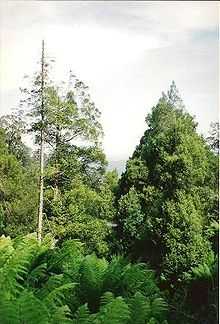Atherosperma
| Atherosperma moschatum | |
|---|---|
 | |
| Atherosperma - near Orbost, Victoria | |
| Scientific classification | |
| Kingdom: | Plantae |
| (unranked): | Angiosperms |
| (unranked): | Magnoliids |
| Order: | Laurales |
| Family: | Atherospermataceae |
| Genus: | Atherosperma Labill. |
| Species: | A. moschatum |
| Subspecies | |
| |
Atherosperma moschatum, the Southern Sassafras or Blackheart Sassafras is an evergreen tree native to the cool temperate rainforests of Tasmania, Victoria and New South Wales in Australia. It is common in the rainforests of Tasmania and Victoria, but more scattered and rare in the higher altitudes of eastern New South Wales. The northernmost area is at Mount Grundy, west of Port Macquarie.
Taxonomy
The southern sassafras was first described by French naturalist Jacques Labillardière in 1806, and is the only member of the genus Atherosperma. Its generic name is derived from the Ancient Greek ather "awn", and sperma "seed", from the hairs on the fruit, and the specific epithet moschatus is the Latin adjective meaning "musk-scented", from the smell of the bark. It is a member of the small family Atherospermataceae along with several other Australian rainforest trees including yellow sassafras (Doryphora sassafras). [1]
Description
The Southern Sassafras is a small to medium sized tree, growing around 6 to 25 metres tall. However, in Tasmania it can reach heights exceeding 40 metres and a width of a metre. It can be identified by the conical shape, the pale green leaves and fragrant scent.
The bark is grey to light brown, with numerous lenticels, raised bumps and ridges. The leaves are 3 to 10 cm long and 8 to 25 mm wide, margins are coarsely toothed, but the northern population in Monga National Park, the Blue Mountains, Barrington Tops and at Mount Grundy has narrow, mostly entire leaves. Now known as Atherosperma moschatum subsp. integrifolium. Leaves, twigs and flowers are fragrant, of a pleasant nutmeg scent.
Flowers form in winter, facing down to avoid rain and snow. White petalled, and yellow (and sometimes maroon) in the centre. The fruit capsules mature and open around January, releasing feathery wind blown seeds. Germination is unreliable. However, abundant new seedlings may unexpectedly form.
Distribution and habitat
The distribution is from the Tia River west of Port Macquarie on the New South Wales mid north coast through Victoria and Tasmania. It is found in the gullies and creek beds of high altitude temperate rainforest, commonly associated with southern beeches of the genus Nothofagus, and mountain quandong (Elaeocarpus holopetalus).[1]
Ecology
The smooth-barked Atherosperma moschatum does not shed its bark annually, and is a rich host of lichen species; a field study in Errinundra National Park found a total of 54 lichen species present, with 11 species found on trees of all sizes measured. The most common recorded was Pannaria microphyllizans. These pockets of rainforest are thought to be critical refuges for populations of lichen species among fire-prone eucalyptus woodland.[2]
Cultivation and uses

The timber is in demand for panelling, turnery, musical instruments and other specialty work, (carvings, dishes and boxes for tourists). The staining of the black heartwood is caused by fungus, and makes the timber markings particularly attractive.
The springy wood has been used for clothes pegs, and the scented bark made into a beverage. Requires moisture and shade for cultivation and hence not commonly seen cultivated.[3]
It has been planted in the British Isles[4] as far north as Northern Ireland[5] and Scotland.[6]
References
- ↑ 1.0 1.1 Floyd, Alex G. (2009). Rainforest Trees of Mainland Southeastern Australia. Lismore, NSW: Terania Rainforest Publishing. p. 83. ISBN 978-0-9589436-7-3.
- ↑ Morley, Sharon E.; Gibson, Maria (2010). "Successional changes in epiphytic rainforest lichens: implications for the management of rainforest communities". The Lichenologist 42 (3): 311–21. doi:10.1017/S0024282909990570.
- ↑ Elliot, Rodger W.; Jones, David L.; Blake, Trevor (1985). Encyclopaedia of Australian Plants Suitable for Cultivation: Vol. 2. Port Melbourne: Lothian Press. p. 253. ISBN 0-85091-143-5.
- ↑ "Half-hardy trees in Britain and Ireland". Royal Horticultural Society. Retrieved 2009-11-04.[broken link]
- ↑ "Atherosperma moschatum". The Garden Flora of Northern Ireland. Retrieved 2009-11-04.
- ↑ "Atherosperma moschatum in Scotland". Dendrological Plant Image Gallery. Retrieved 2009-11-04.
- Forest Trees of Australia, D.J. Boland et al. 1992
External links
- "Atherosperma". Australian Plant Name Index (APNI), IBIS database. Centre for Plant Biodiversity Research, Australian Government.
- "Atherosperma moschatum". Australian Plant Name Index (APNI), IBIS database. Centre for Plant Biodiversity Research, Australian Government.